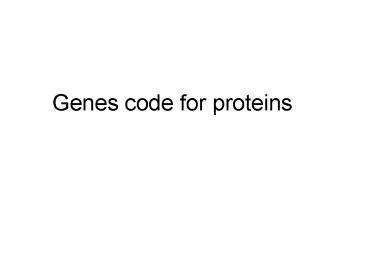Genes code for proteins - PowerPoint PPT Presentation
1 / 19
Title:
Genes code for proteins
Description:
George Beadle (left) and Edward Tatum (right) receiving their Nobel Prizes ' ... It was probably George W. Beadle who brought Garrod to the attention of ... – PowerPoint PPT presentation
Number of Views:46
Avg rating:3.0/5.0
Title: Genes code for proteins
1
Genes code for proteins
2
Archibald E. Garrod (1857-1936)
- In 1896, Archibald E. Garrod, a physician at St.
Bartholomew's Hospital in London, followed up
patients with alkaptonuria, a rare but rather
harmless disorder known as black urine
disease. When exposed to air, patients' urine
turns distinctively dark.
3
Alkaptonuria behaves as a simple recessive
character
- Garrod soon concluded that alkaptonuria is a
congenital disorder, not the result of a
bacterial infection as was commonly thought. - Rare in the general population but frequent in
children of first-cousin marriages, - The incidence of alkaptonuria conformed to the
pattern of simple recessive inheritance described
by Gregor Mendel.
4
1909 publish his results in bookInborn errors of
metabolism
- Garrod understood both the new science of
biochemistry and the emerging discipline of
genetics. - He suspected that, due to a genetic defect,
patients with alkaptonuria failed to breakdown of
protein, resulting in the accumulation of a
chemical that darkens urine..
5
50 years laterAlkaptonuria in humans results
from a block in phenylalanine catabolism
6
George Beadle (left) and Edward Tatum (right)
receiving their Nobel Prizes
"for their discovery that genes act by regulating
definite chemical events 1958 Nobel Prize in
Medicine or Physiology
7
One gene-one metabolic block ? One gene-one
enzyme
- It was probably George W. Beadle who brought
Garrod to the attention of geneticists with his
generous references to Garrod in his 1958 Nobel
lecture. He even suggested that it was Garrod
who first proposed a direct relation between
genes and enzymes.
8
Following genes from generation to generation in
Neurospora crassa
9
Beadle and Tatum's experimental techniques
10
Srb and Horowitz experiment
11
In the following experiment determine the order
of the compounds in the pathway
- A B C D E
- C B A D E
- E B D A C
- C B D A E
- B D A E C
d. is the correct answer
12
In the following experiment determine the order
of the genes controlling the pathway
- C w B x D y A z E
- C y B z D w A x E
- C y B w D z A x E
- C z B y D w A x E
- C x B w D z A y E
b. is the correct answer
13
Sickle cell anemia
Erythrocytes with
Hb A
Hb S
- Hereditary disease of simple recessive
inheritance found mainly among people of African
descent. - Sickle cell anemia (with two abnormal alleles)
- Sicklemia (or sickle cell trait, which carrying
one abnormal allele)
14
The opening of molecular medicine
- Linus Pauling, an Americas leading physical
chemist. - Pauling had studied hemoglobin, discovering
alpha-helix - (Nobel price)
- He assigned the sickle cell anemia project to
Harvey A. Itano in 1946 as a Ph.D thesis topic. - By means of elecrophoresis, Itano finally found
electrophoretic differences in mobility between
normal and sickle cell Hb, indicating that they
carried a different electrical charge.
Linus Pauling 1901-1994
Harvey Itano
15
1957 Vernon Ingram
- Demonstrated that mutations produce amino acid
changes - A specific chemical difference between the
globins of normal human and sickle-cell anemia
hemoglobin. - Nature, Vol.178, pp. 792-794, 1956
16
Broke down peptide chains in small pieces and
analyzed them
descending chromatography
There is a difference in the amino-acid sequence
in one small part of one of the polypeptide
chains, which he named it No. 4 peptide.
17
Then sequenced the poly peptide pieces
Hb A His-Val-Leu-Leu-Thr-Pro-Glu-Glu-Lys Hb S
His-Val-Leu-Leu-Thr-Pro-Val-Glu-Lys
Nature, Vol.180, pp.326-328, 1957
18
The colinearity of gene structure and protein
structure by C. Yanofsky
- TrpA gene (tryptophan synthetase) of E. coli
- 16 mutants with different locations alterations
of the A gene - Constructed a genetic map based on recombination
of mutants - Sequenced the protein products of each mutant and
compared genetic distance with location of the aa
substitution.
Stanford Professor EmeritusCharles Yanofsky
PNAS, 51266, 1964
19
- the colinearity between the DNA and protein
encoded by the DNA. - -- order of observed mutations in the E. coli
tryptophan synthetase gene was the same as the
corresponding amino acid changes in the protein.































